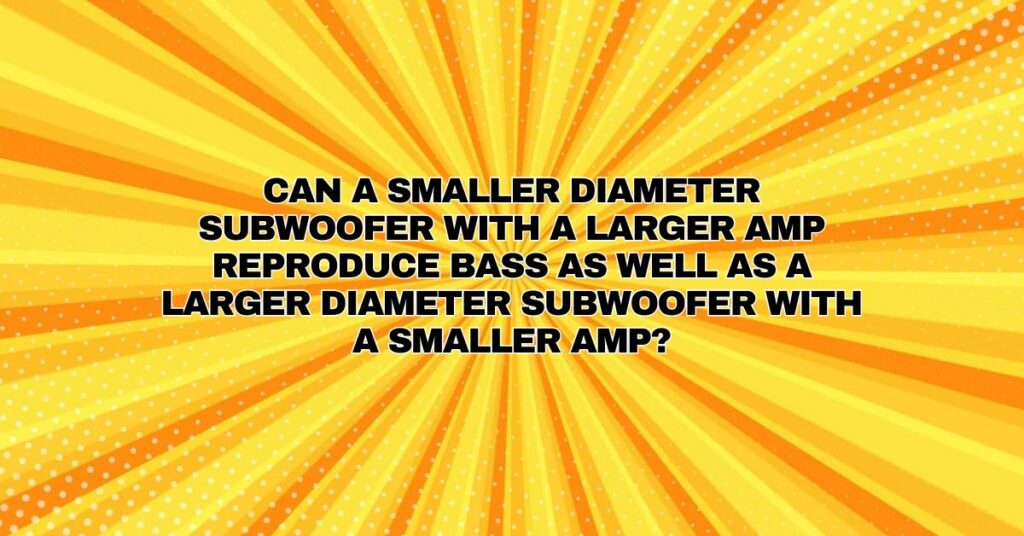The quest for powerful and satisfying bass in your audio system often leads to debates about the relationship between subwoofer size and amplifier power. The common belief is that a larger subwoofer paired with a smaller amplifier will deliver better bass than a smaller subwoofer with a larger amplifier. However, the reality is more nuanced, and the decision hinges on a variety of factors. In this comprehensive guide, we’ll explore the interplay between subwoofer size and amplifier power, helping you make an informed choice for your specific audio needs.
The Subwoofer Size Dilemma
Subwoofers are designed to reproduce low-frequency sound, providing the deep, rumbling bass that adds depth and impact to music, movies, and other audio content. The size of a subwoofer’s driver (the cone) is a key factor in its bass-producing capabilities. Larger subwoofers generally have larger drivers and can move more air, allowing them to generate deeper and more powerful bass. Smaller subwoofers, with correspondingly smaller drivers, are often perceived as having limitations in their ability to reproduce the deepest frequencies.
The Amplifier Power Equation
Amplifiers, on the other hand, are responsible for providing the necessary electrical power to drive the subwoofer’s driver and generate sound. The power rating of an amplifier is typically measured in watts (W) and represents its capability to provide the electrical energy needed to move the subwoofer’s cone. Many assume that a larger amplifier, in terms of power output, can compensate for the limitations of a smaller subwoofer by supplying the extra energy required to produce impactful bass.
The Balance of Subwoofer and Amplifier
The relationship between subwoofer size and amplifier power is a balancing act, and the following factors come into play:
1. Subwoofer Driver Size:
Larger subwoofers with bigger drivers inherently have an advantage when it comes to moving more air and producing deeper bass. They can handle low-frequency notes with less distortion and effort.
2. Amplifier Power:
A more powerful amplifier can provide the necessary energy to drive a subwoofer effectively. Higher wattage amplifiers offer headroom, reducing the risk of distortion during demanding bass passages.
3. Efficiency of Design:
The efficiency of the subwoofer’s design and the quality of both the subwoofer and amplifier play crucial roles. An efficiently designed smaller subwoofer, paired with a high-quality and appropriately powered amplifier, can still deliver impressive bass performance.
4. Room Acoustics:
The characteristics of your listening environment matter. Smaller rooms may benefit from a smaller subwoofer, as they do not require the same level of bass output as larger spaces. The acoustics of your room can impact how bass is perceived and distributed.
5. Listening Preferences:
Your specific audio preferences and listening habits also come into play. If you prioritize precision and accuracy over sheer volume, a smaller subwoofer with a well-matched amplifier may suffice.
In Practice: Making the Right Choice
In practice, choosing between a smaller subwoofer with a larger amplifier or a larger subwoofer with a smaller amplifier depends on several factors:
- Room Size: Consider the size of your listening space. Smaller rooms may not require the immense bass output of a larger subwoofer.
- Bass Goals: Determine your bass goals. Are you seeking earth-shaking, room-rattling bass, or are you more interested in balanced and accurate low-end reproduction?
- Subwoofer and Amplifier Quality: Quality matters. A high-quality smaller subwoofer paired with a well-matched, powerful amplifier can deliver excellent bass performance.
- Budget: Your budget may also influence your decision. Sometimes, investing in a larger, high-quality subwoofer with a well-matched amplifier may be the best route.
Conclusion: Finding the Right Balance
The relationship between subwoofer size and amplifier power is not a one-size-fits-all equation. The best choice depends on your specific audio needs, room characteristics, and budget. Smaller subwoofers with larger amplifiers can indeed produce impressive bass when thoughtfully paired and calibrated. It’s the synergy between the subwoofer and amplifier, along with their quality, that truly determines the bass performance in your audio system. Ultimately, achieving the right balance is the key to satisfying low-frequency reproduction, whether you opt for a smaller subwoofer or a larger one.


